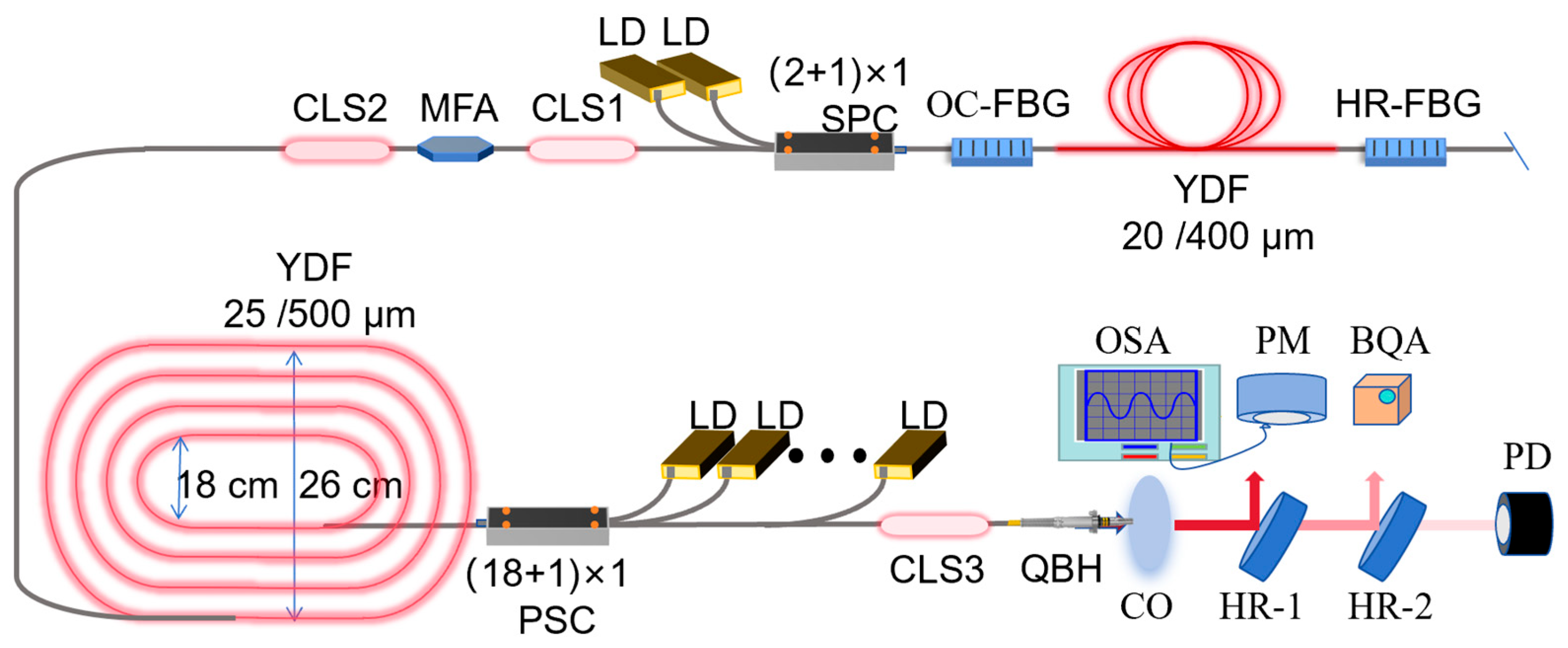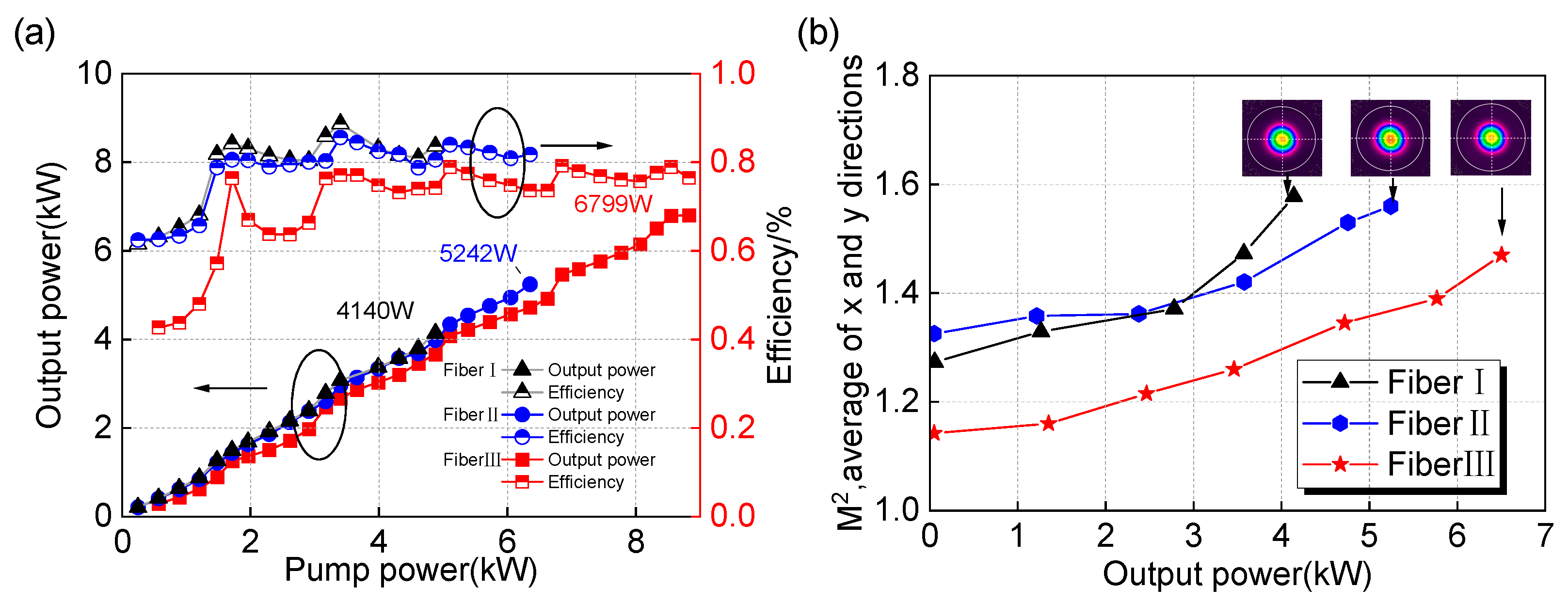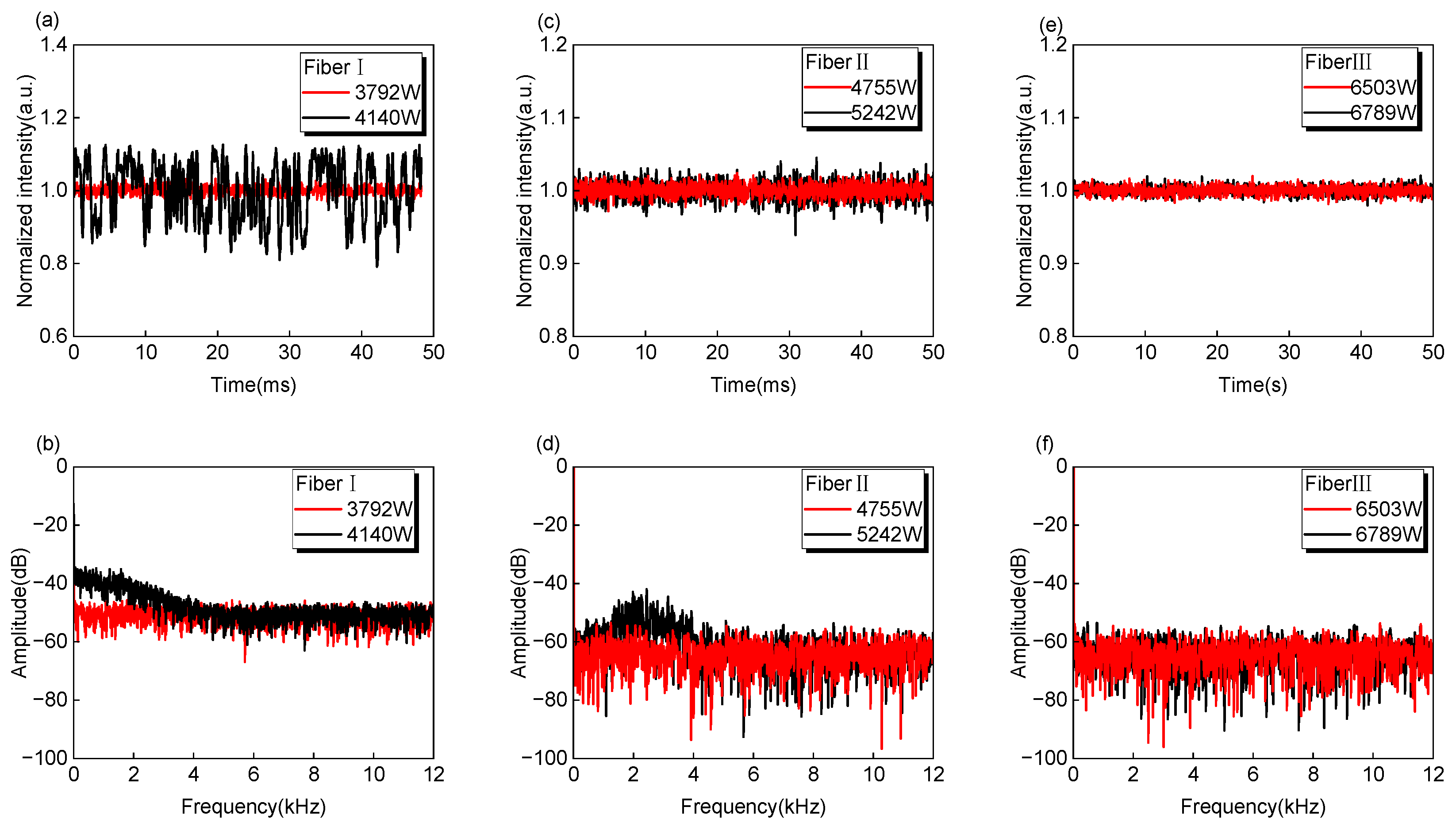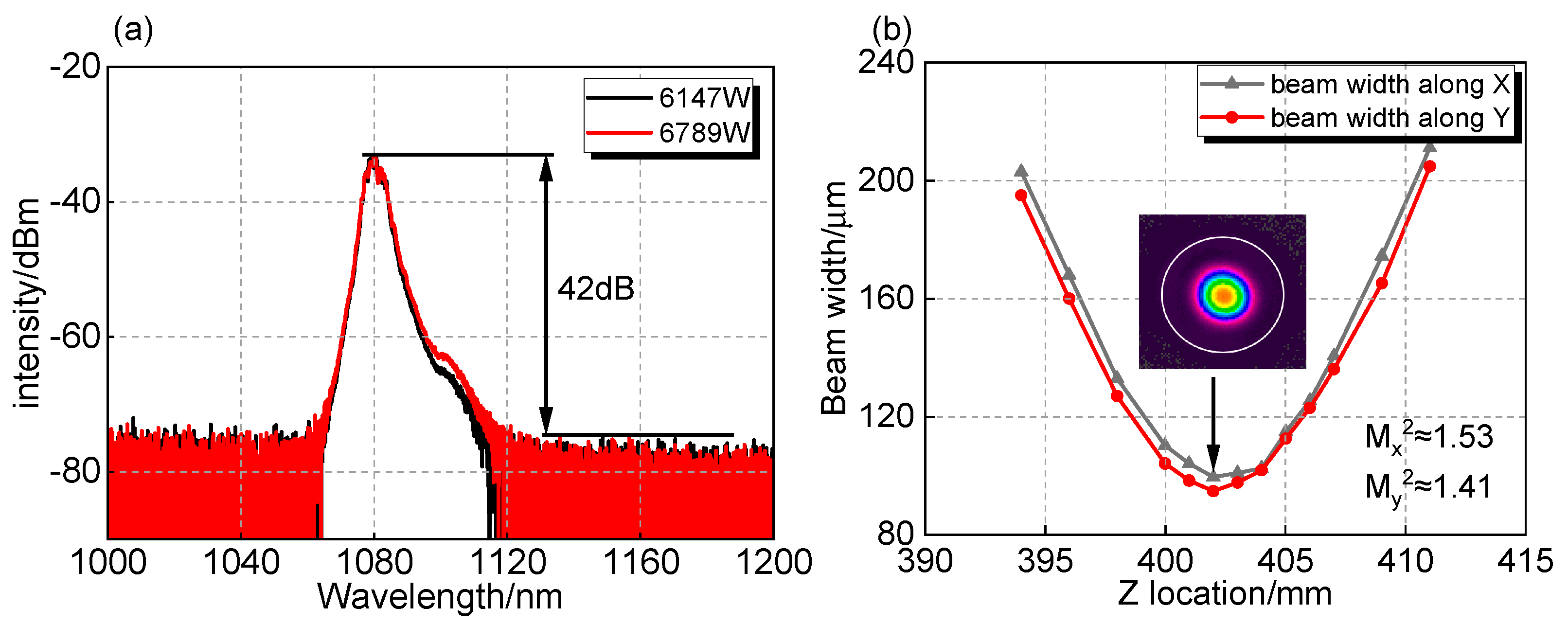6.7 kW LD-Pumped Nearly-Single-Mode MOPA Fiber Laser Enabled by Low-NA Confined-Doped Fiber
Abstract
1. Introduction
2. Experimental Setup
3. Results and Discussion
4. Conclusions
Author Contributions
Funding
Institutional Review Board Statement
Informed Consent Statement
Data Availability Statement
Conflicts of Interest
References
- Nemova, G. Brief review of recent developments in fiber lasers. Appl. Sci. 2024, 14, 2323. [Google Scholar] [CrossRef]
- Wang, Y.B.; Chem, G.; Li, J.Y. Development and prospect of high-power Yb3+ doped fibers. High. Power Laser Sci. Eng. 2018, 6, 19–26. [Google Scholar] [CrossRef]
- Zervas, M.N.; Codemard, C.A. High power fiber lasers: A review. IEEE J. Sel. Top. Quantum Electron. 2014, 20, 219–241. [Google Scholar] [CrossRef]
- Jauregui, C.; Limpert, J.; Tünnermann, A. High-power fibre lasers. Nat. Photonics 2013, 7, 861–867. [Google Scholar] [CrossRef]
- Xiao, H.; Pan, Z.Y.; Chen, Z.L.; Ma, P.F.; Liu, W.; Yang, H.; Yan, Z.P.; Wang, M.; Xi, X.M.; Li, Z.X.; et al. 20 kW fiber laser with high beam quality enabled by tapered ytterbium-doped fiber. High Power Laser Part. Beams 2024, 36, 11001. [Google Scholar]
- Meng, X.M.; Li, F.C.; Chen, J.B.; Xi, X.M.; Yang, B.L.; Wang, P.; Pan, Z.Y.; Yan, Z.P.; Zhang, H.W.; Wang, X.L.; et al. 20 kW monolithic fiber amplifier with directly dual-wavelength laser diodes counter pumping. IEEE Photonics J. 2024, 16, 1503006. [Google Scholar] [CrossRef]
- Wang, Y.; Kitahara, R.; Kiyoyama, W.; Shirakura, Y.; Kurihara, T.; Nakanish, Y.; Yamamoto, T.; Nakayama, M.; Ikoma, S.; Shima, K. 8-kW single-stage all-fiber Yb-doped fiber laser with a BPP of 0.50 mm-mrad. Proc. SPIE 2020, 11260, 1126022. [Google Scholar]
- Ma, P.F.; Yao, T.F.; Liu, W.; Pan, Z.Y.; Chen, Y.S.; Yang, H.; Chen, Z.L.; Wang, Z.F.; Zhou, P.; Chen, J.B. A 7-kW narrow-linewidth fiber amplifier assisted by optimizing the refractive index of the large-mode-area active fiber. High Power Laser Sci. Eng. 2024, 12, e67. [Google Scholar] [CrossRef]
- Platonov, N.; Yagodkin, R.; De La Cruz, J.; Arambula, C.; Fitts, J.; Sergeev, V. 7 kW single-mode ytterbium fiber laser with beam quality parameter M2 < 1.1 and direct diode pumping. Proc. SPIE 2025, 13342, 1334202. [Google Scholar]
- Sidharthan, R.; Lin, D.; Lim, K.; Li, H.; Lim, S.H.; Chang, C.; Seng, Y.; Chua, S.; Jung, Y.; Richardson, D.J.; et al. Ultra-low NA step-index large mode area Yb-doped fiber with a germanium doped cladding for high power pulse amplification. Opt. Lett. 2020, 45, 3828–3831. [Google Scholar] [CrossRef]
- Chen, Y.S.; Ye, Y.; Huang, J.L.; Yang, H.; Wu, H.S.; Yan, Z.P.; Pan, Z.Y.; Wang, X.L.; Wang, Z.F.; Zhou, P. 5 kW-level single-mode fiber amplifier based on low-numerical-aperture fiber. Chin. Opt. Lett. 2024, 22, 41404. [Google Scholar] [CrossRef]
- Beier, F.; Hupel, C.; Kuhn, S.; Hein, S.; Nold, J.; Proske, F.; Sattler, B.; Liem, A.; Jauregui, C.; Limpert, J.; et al. Single mode 4.3 kW output power from a diode-pumped Yb-doped fiber amplifier. Opt. Express 2017, 25, 14892–14899. [Google Scholar] [CrossRef] [PubMed]
- Beier, F.; Möller, F.; Sattler, B.; Nold, J.; Liem, A.; Hupel, C.; Kuhn, S.; Hein, S.; Haarlammert, N.; Schreiber, T.; et al. Experimental investigations on the TMI thresholds of low-NA Yb-doped single-mode fibers. Opt. Lett. 2018, 43, 1291–1294. [Google Scholar] [CrossRef] [PubMed]
- Liu, Y.H.; Zhang, F.F.; Zhao, N.; Lin, X.F.; Liao, L.; Wang, Y.B.; Peng, J.G.; Li, H.Q.; Yang, L.Y.; Dai, N.L. Single transverse mode laser in a center-sunken and cladding-trenched Yb-doped fiber. Opt. Express 2018, 26, 3421–3426. [Google Scholar] [CrossRef]
- Peng, K.; Zhan, H.; Ni, L.; Wang, X.L.; Wang, Y.Y.; Gao, C.; Li, Y.W.; Wang, J.J.; Jing, F.; Lin, A.X. Single-mode large-mode-area laser fiber with ultralow numerical aperture and high beam quality. Appl. Opt. 2016, 55, 10133–10137. [Google Scholar] [CrossRef]
- Jain, D.; Jung, Y.; Barua, P.; Alam, S.; Sahu, J.K. Demonstration of ultra-low NA rare-earth doped step index fiber for applications in high power fiber lasers. Opt. Express 2015, 23, 7407. [Google Scholar] [CrossRef]
- Haarlammert, N.; Sattler, B.; Liem, A.; Strecker, M.; Nold, J.; Schreiber, T.; Eberhardt, R.; Tunnermann, A.; Ludewigt, K.; Jung, M. Optimizing mode instability in low-NA fibers by passive strategies. Opt. Lett. 2015, 40, 2317–2320. [Google Scholar] [CrossRef]
- Marciante, J.R.; Roides, R.G.; Shkunov, V.V.; Rockwell, D.A. Near-diffraction-limited operation of step-index large-mode-area fiber lasers via gain filtering. Opt. Lett. 2010, 35, 1828–1830. [Google Scholar] [CrossRef]
- Eidam, T.; Hädrich, S.; Jansen, F.; Stutzki, F.; Rothhardt, J.; Carstens, H.; Jauregui, C.; Limpert, J.; Tünnermann, A. Preferential gain photonic-crystal fiber for mode stabilization at high average powers. Opt. Express 2011, 19, 8656–8661. [Google Scholar] [CrossRef]
- Jauregui, C.; Otto, H.; Breitkopf, S.; Limpert, J.; Tünnermann, A. Optimizing high-power Yb-doped fiber amplifier systems in the presence of transverse mode instabilities. Opt. Express 2016, 24, 7879–7892. [Google Scholar] [CrossRef]
- Liao, L.; Zhang, F.F.; He, X.F.; Chen, Y.S.; Wang, Y.B.; Li, H.Q.; Peng, J.G.; Yang, L.Y.; Dai, N.L.; Li, J.Y. Confined-doped fiber for effective mode control fabricated by MCVD process. Appl. Opt. 2018, 57, 3244–3249. [Google Scholar] [CrossRef] [PubMed]
- Zhang, F.F.; Wang, Y.B.; Lin, X.F.; Cheng, Y.S.; Zhang, Z.L.; Liu, Y.H.; Liao, L.; Xing, Y.B.; Yang, L.Y.; Dai, N.L.; et al. Gain-tailored Yb/Ce codoped aluminosilicate fiber for laser stability improvement at high output power. Opt. Express 2019, 27, 20824. [Google Scholar] [CrossRef] [PubMed]
- Zhang, Z.L.; Luo, Y.H.; Cheng, J.J.; Liao, S.B.; Wang, X.L.; Xing, Y.B.; Li, H.Q.; Peng, J.G.; Dai, N.L.; Li, J.Y. Investigation of gain-filtering Yb-doped fibers with different gain-dopant doping ratios for high power amplifier. Opt. Fiber Technol. 2023, 81, 103529. [Google Scholar] [CrossRef]
- Cui, N.; Liu, L.; Guo, S.F.; He, J.; Wang, Q.G.; Gao, B. 5 kW single-mode oscillating-amplifying integrated fiber laser through tightly bent confined ytterbium-doped fiber. Opt. Express 2024, 32, 45707–45719. [Google Scholar] [CrossRef]
- Ma, X.Q.; Zhu, C.; Hu, I.; Kaplan, A.; Galvanauskas, A. Single-mode chirally-coupled-core fibers with larger than 50 µm diameter cores. Opt. Express 2014, 22, 9206–9219. [Google Scholar] [CrossRef]
- Zhang, X.; Gao, S.; Wang, Y.Y.; Ding, W.; Wang, P. Design of large mode area all-solid anti-resonant fiber for high-power lasers. High Power Laser Sci. Eng. 2021, 9, 166–172. [Google Scholar] [CrossRef]
- An, Y.; Li, F.C.; Yang, H.; Chen, X.; Huang, L.J.; Yan, Z.P.; Jiang, M.; Yang, B.L.; Wang, P.; Pan, Z.Y.; et al. Single trench fiber-enabled high-power fiber laser. Photonics 2024, 11, 615. [Google Scholar] [CrossRef]
- Jain, D.; Jung, Y.; Nunez-Velazquez, M.; Sahu, J.K. Extending single mode performance of all-solid large-mode-area single trench fiber. Opt. Express 2014, 22, 31078–31091. [Google Scholar] [CrossRef]
- Kanskar, M.; Zhang, J.; Koponen, J.; Kimmelma, O.; Aallos, V.; Hu, I.; Galvanauskas, A. Narrowband transverse-modal-instability (TMI)-free Yb-doped fiber amplifiers for directed energy applications. Proc. SPIE 2018, 10512, 105120F. [Google Scholar]
- Zhang, F.F.; Xu, H.Z.; Xing, Y.B.; Hou, S.D.; Chen, Y.S.; Li, J.Y.; Dai, N.L.; Li, H.Q.; Wang, Y.B.; Liao, L. Bending diameter dependence of mode instabilities in multimode fiber amplifier. Laser Phys. Lett. 2019, 16, 1612–2011. [Google Scholar] [CrossRef]
- Wen, Y.J.; Wang, P.; Shi, C.; Yang, B.L.; Xi, X.M.; Zhang, H.W.; Wang, X.L. Experimental study on transverse mode instability characteristics of few-mode fiber laser amplifier under different bending conditions. IEEE Photonics J. 2022, 14, 1539106. [Google Scholar]
- Huang, Z.M.; Shu, Q.; Luo, Y.; Tao, R.M.; Feng, X.; Liu, Y.; Lin, H.H.; Wang, J.J.; Jing, F. 3.5 kW narrow-linewidth monolithic fiber amplifier at 1064 nm by employing a confined doping fiber. J. Opt. Soc. Am. B Opt. Phys. 2021, 38, 2945–2952. [Google Scholar] [CrossRef]
- Zhang, Z.L.; Lin, X.F.; Zhang, X.; Luo, Y.H.; Liao, S.B.; Wang, X.L.; Chen, G.; Xing, Y.B.; Li, H.Q.; Peng, J.G.; et al. Low-numerical aperture confined-doped long-tapered Yb-doped silica fiber for a single-mode high-power fiber amplifier. Opt. Express 2022, 30, 32333–32346. [Google Scholar] [CrossRef]
- Zhang, J.P.; Chen, X.L.; Bai, G.; He, Y.; Liu, K.; He, B.; Zhou, J. Optimization of seed power for suppression of stimulated raman scatting in all-fiber amplifiers. Laser Phys. Lett. 2019, 16, 35101. [Google Scholar] [CrossRef]





| Fiber Type | Core Diameter (µm) | NA | Clad Diameter (µm) | Yb-Doping Ratio (%) | Absorption Coefficient at 915 nm (dB/m) | Fiber Length (m) |
|---|---|---|---|---|---|---|
| Fiber-I | 25.1 | 0.058 | 499.0 | ~80 | 0.34 | ~28 |
| Fiber-II | 25.2 | 0.053 | 500.1 | ~80 | 0.31 | ~28 |
| Fiber-III | 25.4 | 0.048 | 500.6 | ~80 | 0.26 | ~28 |
Disclaimer/Publisher’s Note: The statements, opinions and data contained in all publications are solely those of the individual author(s) and contributor(s) and not of MDPI and/or the editor(s). MDPI and/or the editor(s) disclaim responsibility for any injury to people or property resulting from any ideas, methods, instructions or products referred to in the content. |
© 2025 by the authors. Licensee MDPI, Basel, Switzerland. This article is an open access article distributed under the terms and conditions of the Creative Commons Attribution (CC BY) license (https://creativecommons.org/licenses/by/4.0/).
Share and Cite
Tang, H.; Rao, B.; Gan, Y.; Yang, B.; Wang, F.; Zhang, L.; Wang, M.; Hu, L.; Chen, Z.; Xiao, H.; et al. 6.7 kW LD-Pumped Nearly-Single-Mode MOPA Fiber Laser Enabled by Low-NA Confined-Doped Fiber. Photonics 2025, 12, 971. https://doi.org/10.3390/photonics12100971
Tang H, Rao B, Gan Y, Yang B, Wang F, Zhang L, Wang M, Hu L, Chen Z, Xiao H, et al. 6.7 kW LD-Pumped Nearly-Single-Mode MOPA Fiber Laser Enabled by Low-NA Confined-Doped Fiber. Photonics. 2025; 12(10):971. https://doi.org/10.3390/photonics12100971
Chicago/Turabian StyleTang, Hengyu, Bingyu Rao, Yufei Gan, Baolai Yang, Fan Wang, Lei Zhang, Meng Wang, Lili Hu, Zilun Chen, Hu Xiao, and et al. 2025. "6.7 kW LD-Pumped Nearly-Single-Mode MOPA Fiber Laser Enabled by Low-NA Confined-Doped Fiber" Photonics 12, no. 10: 971. https://doi.org/10.3390/photonics12100971
APA StyleTang, H., Rao, B., Gan, Y., Yang, B., Wang, F., Zhang, L., Wang, M., Hu, L., Chen, Z., Xiao, H., Li, Z., Ma, P., & Wang, Z. (2025). 6.7 kW LD-Pumped Nearly-Single-Mode MOPA Fiber Laser Enabled by Low-NA Confined-Doped Fiber. Photonics, 12(10), 971. https://doi.org/10.3390/photonics12100971





